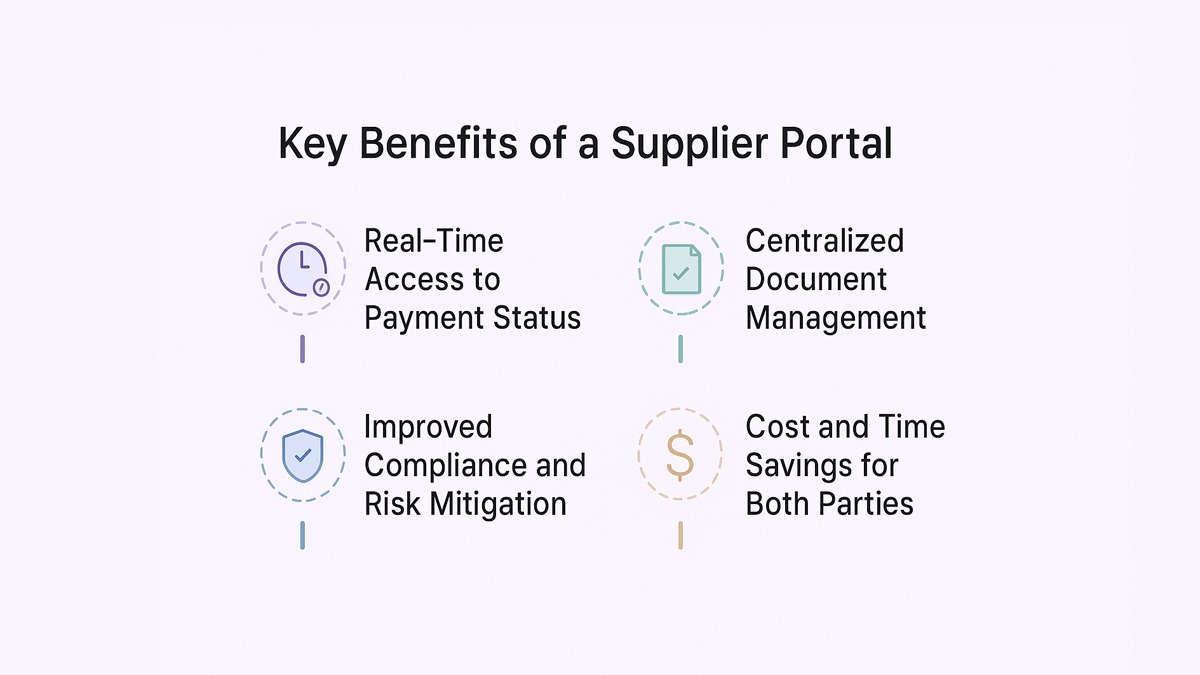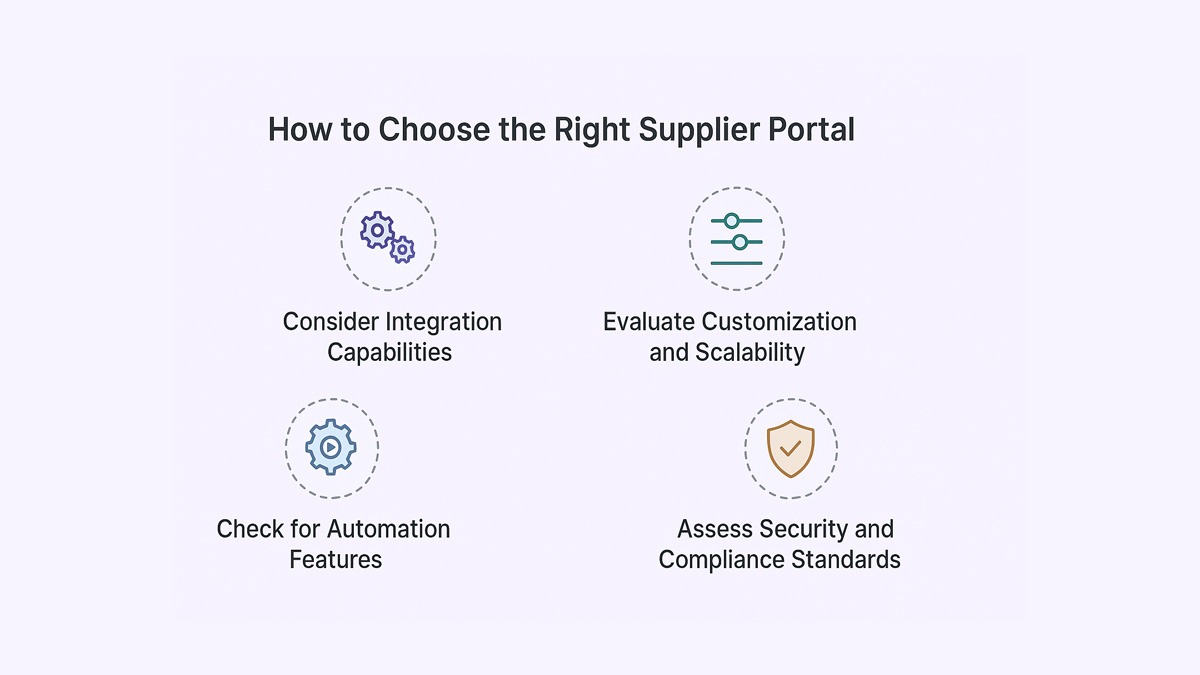

The Supplier Portal Advantage: What Your Procurement Team Is Missing

The Supplier Portal Advantage: What Your Procurement Team Is Missing
Understand supplier portals and how they enhance procurement, invoicing, and supplier collaboration.


Managing vendor relationships can feel like juggling on a tightrope - one misstep, and things fall apart. But imagine if vendors had a single, always-on hub where they could track payments, upload invoices, and collaborate with your team in real time. That’s the power of a supplier portal. It simplifies procurement, strengthens relationships, and keeps operations running like clockwork.
What this blog covers:
- What is a supplier portal
- Why is a supplier portal important
- Key benefits of a supplier portal
- How to achieve success with a supplier portal
- Choosing the right supplier portal for your business
- How Spendflo helps with supplier collaboration and visibility
- Frequently asked questions on supplier portals
What is a Supplier Portal?
A supplier portal is a secure digital platform that allows suppliers and buyers to communicate, exchange documents, and manage transactions in one place. It streamlines vendor onboarding, purchase orders, invoicing, and payment tracking - reducing errors and improving visibility for both parties.
Why is a Supplier Portal Important
A supplier portal isn’t just a nice-to-have - it’s a key enabler of operational efficiency and strategic supplier management. It brings order to what is often a chaotic, manual process and helps companies foster more reliable, data-driven relationships with vendors. Here’s why supplier portals have become essential in modern procurement:
Improves Supplier Collaboration
When suppliers can log in and access real-time updates, upload documents, and view purchase orders all in one place, collaboration becomes seamless. It reduces misunderstandings, improves response times, and keeps both sides on the same page - literally and figuratively.
Speeds Up Invoice Processing
By eliminating email-driven submissions and manual data entry, supplier portals streamline the invoice lifecycle. Vendors submit invoices directly through the portal, where automated routing and validation checks kick in. This greatly reduces manual errors when handling vendor invoices. It also accelerates approvals and ensures vendors get paid on time - every time.
Reduces Manual Errors and Delays
Manual workflows are prone to mistakes: duplicate entries, missing information, or outdated forms. A supplier portal automates checks and ensures required fields are filled, cutting down errors and rework. That means fewer fires to put out and more time spent on high-value work.
Boosts Supply Chain Visibility
Portals give procurement and finance teams real-time visibility into supplier performance, order statuses, invoice timelines, and compliance. This visibility is especially useful for supply chain managers coordinating multiple vendors. With clear data at their fingertips, teams can plan better, anticipate delays, and make more informed decisions - no guesswork required.
Key Benefits of a Supplier Portal
The true value of a supplier portal lies in the consistency and control it brings to vendor relationships. It’s not just about digitizing procurement - it’s about unlocking efficiencies, reducing risk, and making collaboration feel less like a chore and more like a partnership. Below are the key benefits organizations can expect:

Real-Time Access to Payment Status
Suppliers no longer need to send emails or make phone calls asking, “When will I get paid?” With real-time visibility into payment statuses, they can track invoices, approvals, and due dates independently. Some portals even support electronic payments to speed up the settlement process. This self-service model improves trust and minimizes friction in the payment cycle.
Centralized Document Management
Contracts, purchase orders, invoices, tax forms - everything is stored and accessible in one place. This reduces dependency on email attachments or disconnected systems, and ensures that procurement and finance teams can always find the right documents when they need them.
Improved Compliance and Risk Mitigation
Portals often include built-in checks to validate information before it’s submitted - like matching invoice details with purchase orders. This reduces the chances of non-compliant vendors slipping through the cracks and ensures that procurement stays audit-ready at all times. Teams can also check vendor compliance status directly from the portal dashboard.
Cost and Time Savings for Both Parties
Automated workflows eliminate repetitive, manual tasks like emailing invoices or chasing for approvals. These automations also reduce bottlenecks in AP workflows. For vendors, this means faster payments. For internal teams, it means fewer hours spent on admin work - freeing up time to focus on strategic sourcing and supplier development. For finance teams, it means more control over payment processes.
Faster Dispute Resolution
If there’s an issue with a delivery or a payment discrepancy, both parties have access to the same records and timelines. This shared visibility shortens the feedback loop and leads to faster, more constructive resolutions. It also strengthens incident response by enabling both sides to address issues swiftly.
Better Supplier Engagement
When suppliers feel empowered - because they’re not left in the dark - they engage more meaningfully. A portal helps shift the dynamic from transactional to collaborative, laying the groundwork for long-term, high-value vendor partnerships.
How to Achieve Success With a Supplier Portal
Getting a supplier portal up and running is a strong first step - but long-term success depends on how well it’s adopted, managed, and optimized. To ensure your portal becomes a strategic asset (and not just another underused tool), focus on these foundational best practices:
Ensure User-Friendly Design and Navigation
The portal should feel intuitive - like a well-designed app, not clunky enterprise software. It should also be easy to update vendor information in real time. If suppliers struggle to find buttons or navigate workflows, adoption will suffer. Keep the interface clean, use simple language, and test it with actual vendors before rollout.
Train Suppliers and Internal Teams
A smooth onboarding process is crucial. Offer quick-start guides, short training videos, and live Q&A sessions. Higher vendor adoption improves portal ROI and ensures better data consistency. Internal teams also need to understand the value of the portal and how it fits into their daily workflows - so they become champions, not bottlenecks.
Establish Clear Communication Protocols
Set expectations early. What should suppliers do if they hit a snag? Where should they upload tax forms? Who do they contact for payment queries? Establishing these guidelines upfront reduces confusion and keeps everyone aligned.
Track Metrics and Optimize Continuously
Monitor key KPIs like supplier adoption rates, invoice processing time, error rates, and open support tickets. Performance tracking tools make it easier to measure success and drive improvements. Use this data to fine-tune processes, identify gaps, and demonstrate ROI to leadership. Procurement teams can also unlock valuable customer insights through consistent supplier performance data. A portal should evolve alongside your business - not stay static.
Choosing the Right Supplier Portal for Your Business
With so many supplier portals on the market, picking the right one can feel overwhelming. But it doesn’t have to be. The procurement software market now offers several portals tailored to different business sizes and needs. The key is to focus less on bells and whistles, and more on alignment - how well the portal fits your processes, goals, and supplier ecosystem. Here’s what to prioritize:

Consider Integration Capabilities
Your supplier portal shouldn’t live in a silo. It needs to connect easily with your ERP, procurement system, accounts payable tools, and contract management platform. Integration ensures real-time data sync, eliminates redundant entry, and keeps everyone working from the same source of truth.
Evaluate Customization and Scalability
Every business has its quirks. The ideal portal lets you tailor workflows, permissions, and branding to match how your team actually works. It should also scale with you - handling hundreds or even thousands of suppliers as you grow, without performance issues or usability drop-offs. A scalable portal can adapt as your supply network expands globally.
Check for Automation Features
Look for automation around invoice matching, approval routing, supplier onboarding, and notification alerts. The more routine steps you can remove from your team’s plate, the more time they’ll have to focus on strategic initiatives.
Assess Security and Compliance Standards
Sensitive financial and vendor data flows through the portal daily. Make sure it offers robust access controls, encryption, audit trails, and compliance with global standards like GDPR or SOC 2. Security shouldn’t be an afterthought - it’s table stakes. These features help ensure alignment with internal compliance policies.
Evaluate Support and Onboarding Services
A great platform is only half the equation. You also need responsive vendor support and structured onboarding services to help suppliers get set up quickly. The smoother the rollout, the faster you’ll see adoption - and ROI.
How Spendflo Helps With Supplier Collaboration and Visibility
Spendflo takes the guesswork out of supplier management by offering a centralized, easy-to-use platform where procurement and finance teams can oversee every part of the vendor relationship - from contracts and approvals to renewals and payments. Suppliers get a streamlined experience too, with real-time updates, fewer manual touchpoints, and faster resolution of queries. The result? Less back-and-forth, fewer delays, and stronger, more transparent partnerships. With Spendflo, collaboration isn’t just easier - it’s built into the process by design.
Frequently Asked Questions on Supplier Portals
What are the key features of a supplier portal?
Supplier portals typically include features like invoice submission, real-time payment tracking, purchase order access, contract storage, compliance checks, and communication tools. These features help streamline collaboration between buyers and suppliers.
How does a supplier portal improve procurement efficiency?
By automating manual tasks, reducing back-and-forth communication, and centralizing all
procurement-related documents, supplier portals significantly cut processing time and reduce human errors. This leads to faster approvals, better compliance, and smoother workflows.
What should you consider when choosing a supplier portal?
Key considerations include ease of use, integration with your existing systems, automation capabilities, security features, vendor onboarding support, and the ability to scale with your supplier network.
Can supplier portals help with contract compliance?
Yes. Many supplier portals offer built-in reminders, document validation, and audit trails to ensure vendors meet contractual obligations. This reduces non-compliance risks and keeps procurement teams in control.
How do supplier relationships impact procurement success?
Strong supplier relationships lead to better collaboration, smoother communication, and improved contract outcomes. They also reduce friction during negotiations and help businesses secure favorable pricing and service levels.
What are the benefits of single sign-on in supplier portals?
Single sign-on (SSO) simplifies access for vendors by letting them log into the supplier portal with one set of credentials. It improves user experience, enhances security, and reduces password fatigue.










.png)




.png)










.avif)





